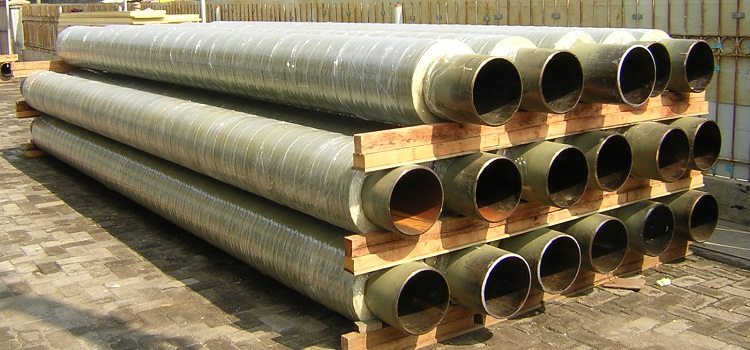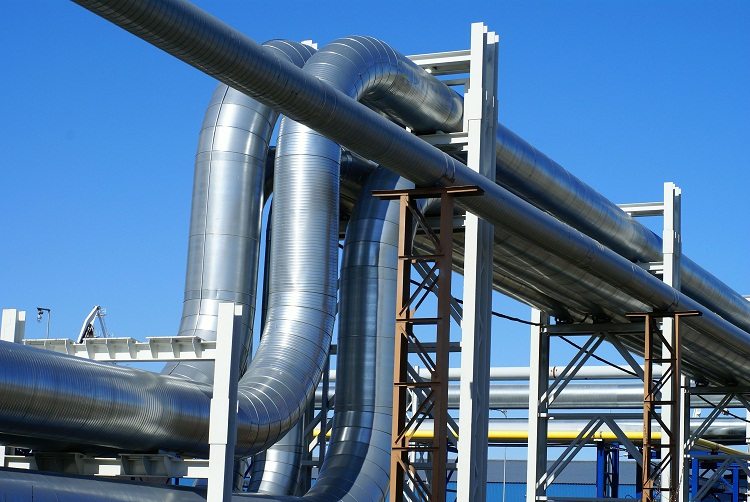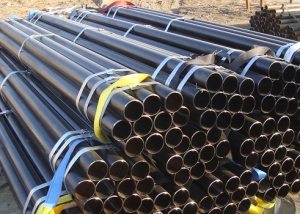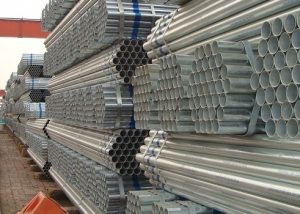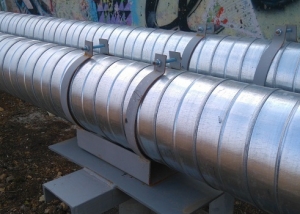Insulation of steel pipes is one of the most important stages of laying pipelines for various purposes (for heating systems, hot water supply networks and others). Thanks to a special casing, for example, made of polyurethane foam (PUF), it is possible to reduce heat loss during operation of the pipeline. The use of pre-insulated pipes reduces costs by about 6 times.
Content
Types of shells of steel pipes in polyurethane foam
Depending on operating conditions, heat-insulated steel pipes in polyurethane foam can be additionally equipped with protective shells
- from polyethylene (PE);
- made of galvanized steel (OC).
Polyethylene is a thermoplastic ethylene polymer that exhibits frost and chemical resistance, dielectric properties, a lack of sensitivity to shock, and low adhesion. Galvanized steel is obtained by coating the metal with a protective layer, which, when oxidized in air, forms a dense film that prevents the spread of corrosion.
An insulated pipe in polyurethane foam with a polyethylene sheath has a higher level of water protection in the conditions of laying channels underground. Since such products are manufactured, taking into account temperature changes in the coolant, they are widely used for channel-free installation.
Note! For aboveground networksth apply pipes in polyurethane foam, isolated by galvanized steel.
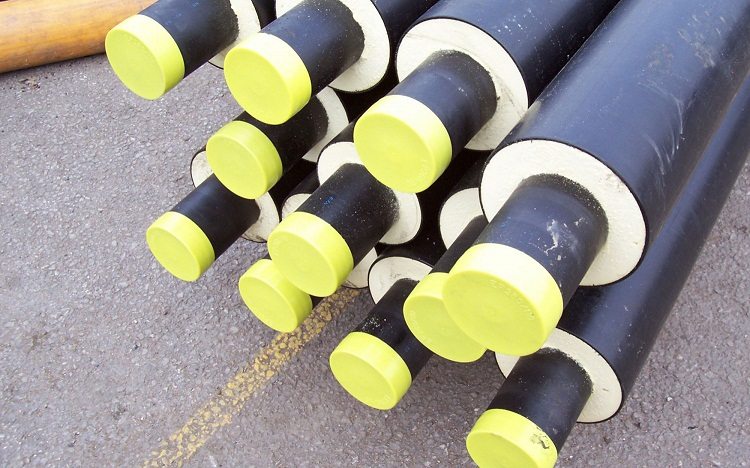
The polyethylene shell is resistant to stress, but the pipes are suitable for use in difficult weather conditions.
Products are produced immediately with indicators and conductors of the UEC system, which allows you to obtain information about the state of the insulating layer and quickly respond to malfunctions when performing repairs.
Characteristics of a steel pipe in polyurethane foam insulation
The main technical parameters of pipes (steel) in the insulation of polyurethane foam with protective shells made of PE or OC are given in GOST 30732 from 2006. This document defines the characteristics for products with such design characteristics of the coolant:
- working pressure: 1600 kPa (no more);
- temperature: no more than 140 degrees (permissible up to 150 ºС).
Underground tunneling of networks is allowed in a PE channel, as well as in tunnels and passageways in the OC shell. A comparison of the parameters of pipes insulated with PUF or other materials is given in the table.
Table 1
| Name of indicator | Materials used | unit of measurement | |||
| PPU | Bitum perlite | Reinforced concrete | Phenolic foam | ||
| Density, including thermal insulation layer | 80-100 | 450-600 | 500-600 | 100 | kg / m3 |
| 80 | 550 | 500 | 100 | ||
| Strength limit:
- when bending - during compression |
300 |
200 |
300 |
300 |
kPa |
| 400 | 800 | 200 | |||
| Pipe adhesion | 120 | No | 100 | 120 | kPa |
| Water absorption (20 ºС) by weight | 8 | 90 | 150 | 600 | % for thirty days |
| Corrosion rate without / with anodic polarization | 0,05/0,10 | 0,55/0,75 | 0,35/0,65 | 0,37/0,50 | mm per year |
| pH of the starting medium | 7,0 | 5,0 | 10,0 | 5,0 | — |
| Thermal conductivity at maximum operating temperature | 40 | 120 | 130 | 40 | mW / mºС |
| Heat resistance | 130 | 130 | 180 | 150 | ºС |
| Life time | 25-30 | 8 | 15 | 15 | Years old |
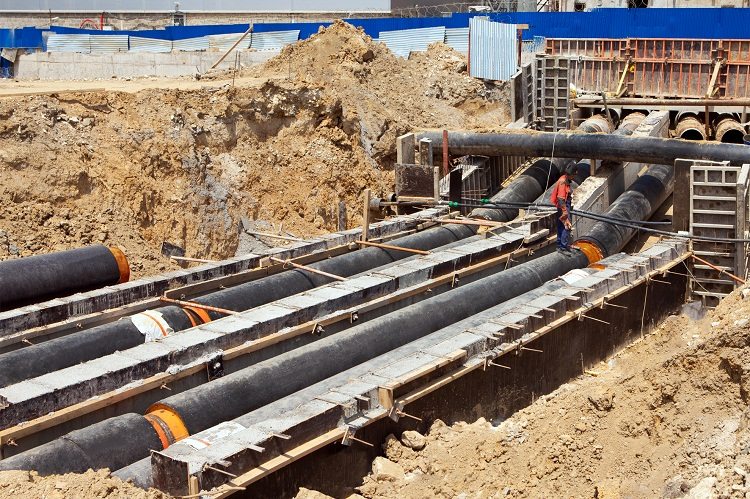
Pipes in polyurethane foam insulation with a polyethylene sheath are suitable for underground installation
For all materials, mandatory processing of the pipe for insulation is necessary.
Dimensions of products in a PE shell
The standard establishes the dimensions of steel pipes in polyurethane foam OTs or polyethylene shells.Their outer diameter is 3.2-142.0 cm; length: for sections less than 21.9 centimeters - 8-12 m, more than 273 mm - 10-12 m.
Note! There are 2 types of structures with a PE shell: standard (type 1) and reinforced (type 2).
The table shows the dimensions of the pipes in the polyurethane foam and the values of the maximum deviations.
table 2
| Outside diameter (cm) and minimum wall (mm) | For type 1 | For type 2 | ||||
| The average outer diameter of insulated products with PE, cm | The estimated value of the thickness of the foam, cm | The average outer diameter of insulated products with PE, cm | The estimated thickness of the foam, cm | |||
| nominal | deviation (+) | nominal | deviation (+) | |||
| 3.2x3.0 | 9,0; 11,0; 12,5 | 0,27; 0,35; 0,37 | 2,6; 3,65; 4,35 | — | — | — |
| 3.8x3.0 | 11,0; 12,5 | 0,32; 0,37 | 3,3; 4,05 | — | — | — |
| 4,5x3,0 | 12,5 | 0,37 | 3,7 | — | — | — |
| 5.7x3.0 | 12,5 | 0,37 | 3,15 | 14,0 | 0,41 | 3,85 |
| 7.6x3.0 | 14,0 | 0,41 | 2,9 | 16,0 | 0,47 | 3,9 |
| 8.9x4.0 | 16,0 | 0,47 | 3,25 | 18,0 | 0,54 | 4,25 |
| 10.8x4.0 | 18,0 | 0,54 | 3,3 | 20,0 | 0,59 | 4,3 |
| 13.3x4.0 | 22,5 | 0,66 | 4,25 | 25,0 | 0,74 | 5,45 |
| 15.9x4.5 | 25,0 | 0,74 | 4,15 | 28,0 | 0,83 | 5,55 |
| 21.9x6.0 | 31,5 | 0,98 | 4,2 | 35,5 | 1,04 | 6,2 |
| 27.3x7.0 | 40,0 | 1,17 | 5,7 | 45,0 | 1,32 | 8,15 |
| 32.5x7.0 | 45,0 | 1,32 | 5,55 | 50,0 | 1,46 | 7,95 |
| 42.6x7.0 | 56,0 | 1,63 | 5,82 | 60,0; 63,0 | 1,63 | 7,76; 9,25 |
| 53.0x7.0 | 71,0 | 2,04 | 7,89 | — | — | — |
| 63.0x8.0 | 80,0 | 2,34 | 7,25 | — | — | — |
| 72.0x8.0 | 90,0 | 2,63 | 7,6 | — | — | — |
| 82.0x9.0 | 100,0 | 2,92 | 7,24 | 110,0 | 3,21 | 12,25 |
| 92.0x10.0 | 110,0 | 3,21 | 7,44 | 120,0 | 3,51 | 12,05 |
| 102.0x11.0 | 120,0 | 3,51 | 7,04 | — | — | — |
| 122.0x11.0 | 142,5 | 3,82 | 7,9 | — | — | — |
| 142.0x12.0 | 160,0 | 4,12 | 9,0 | — | — | — |
Sizes of pipes in the shell of OTs
GOST defines the main dimensions of the products in the OC shell. The corresponding values are given in the table.
Table 3
| Steel pipe outer diameter (cm) and minimum wall thickness (mm) | Dimensions of a protective shell made of OTs | The thickness of the polyurethane foam layer (calculated), cm | |
| nominal diameter cm | thickness (minimum), mm | ||
| 3.2x3.0 | 10,0; 12,5; 14,0 | 0,55 | 4,6; 5,35 |
| 3.8x3.0 | 12,5; 14,0 | 4,3; 5,05 | |
| 4,5x3,0 | 12,5; 14,0 | 3,95; 4,7 | |
| 5.7x3.0 | 14,0 | 4,09 | |
| 7.6x3.0 | 16,0 | 4,14 | |
| 8.9x4.0 | 18,0 | 0,6 | 4,49 |
| 10.8x4.0 | 20,0 | 4,54 | |
| 13.3x4.0 | 22,5 | 4,54 | |
| 15.9x4.5 | 25,0 | 0,7 | 4,48 |
| 21.9x6.0 | 31,5 | 0,7 | 4,73 |
| 27.3x7.0 | 40,0 | 0,8 | 6,27 |
| 32.5x7.0 | 45,0 | 0,8 | 6,17 |
| 42.6x7.0 | 56,0 | 1,0 | 6,62 |
| 53.0x7.0 | 67,5; 71,0 | 7,15; 8,90 | |
| 63.0x8.0 | 77,5; 80,0 | 7,15; 8,40 | |
| 72.0x8.0 | 87,5; 90,0 | 1,0 | 7,65; 8,90 |
| 82.0x9.0 | 97,5; 100,0 | 7,65; 8,90 | |
| 92.0x10.0 | 107,5; 110,0 | 1,0 | 7,65; 8,90 |
| 102.0x11.0 | 117,5; 120,0 | 7,67; 8,92 | |
| 122.0x11.0 | 137,5; 140,0 | 7,90; 9,15 | |
| 142.0x12.0 | 157,5; 160,0 | 7,70; 8,95 | |
In order to extend the operational life, it is allowed to additionally cover the OTs coating with a special composition (paint, polymer, etc.). In the process of using products, it can be renewed.
Requirements for insulated channels
Regulatory document 30732 defines the structure of the symbol for thermally insulated products. So, the pipe should be applied:
- abbreviated name of the material (Art);
- outer diameter (in mm);
- wall (in mm);
- type of insulation for pipes with PE (1 or 2);
- abbreviated name of the insulation material (PPU);
- protective shell (polyethylene PE, OTs);
- standard.
In the manufacture of pipes, the space between the inner steel and the outer (PE or OC) pipe is filled with polyurethane foam. Due to the insignificant adhesive properties of polyurethane foam, there is almost no absorption of moisture into the material, which determines its ability to withstand high humidity. The surface of the finished channels must be cleaned of grease, rust, oil, scale, and dried.
Note! When PPU leaks through the seam of shells made of steel, their sealing is permissible.
The indicator conductors of the UEC system should be made of copper (MM), have a cross section of one and a half square millimeters and be located at a distance of 20 mm from the pipe wall with a possible deviation of ± 2 mm. For the manufacture of polymer shells, PE grades of at least 80 are used.
The ignition temperature of the PUF is 550-600 degrees and during combustion it emits highly toxic products. For this reason, in the event of a flame, it is extinguished in an insulating gas mask.
Pipes made of steel with PE or OC have a mechanically maintenance-free, long service life, are characterized by low thermal conductivity, resistant to external influences of atmospheric phenomena, alkalis and allow you to quickly install networks of various configurations and purposes.
